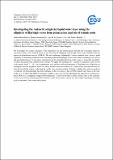Por favor, use este identificador para citar o enlazar a este item:
http://hdl.handle.net/10261/203035COMPARTIR / EXPORTAR:
 SHARE
BASE SHARE
BASE
|
|
| Visualizar otros formatos: MARC | Dublin Core | RDF | ORE | MODS | METS | DIDL | DATACITE | |

| Título: | Investigating the Antarctic subglacial liquid water layer using the ellipticity of Rayleigh waves from polarization analysis of seismic noise |
Autor: | Berbellini, Andrea; Schimmel, Martin CSIC ORCID ; Ferreira, Ana M. G.; Morelli, A. | Palabras clave: | Seismology | Fecha de publicación: | 7-abr-2019 | Editor: | European Geosciences Union | Citación: | Geophysical Research Abstracts, 21: EGU2019-7560 (2019) | Resumen: | We investigate the seismic structure of the uppermost ice and crustal layers beneath the Concordia station in Antarctica using a new method based on the inversion of ellipticity of Rayleigh waves from ambient noise by degree-of-polarization analysis (DOP-E). The new technique, validated by various synthetic tests, shows a good capability of separating ambient noise containing polarized Rayleigh waves from noise containing Love waves and uncorrelated noise. It also gives information on the azimuthal direction of the sources, giving the possibility to better characterise the ambient noise sources. We apply this technique to 1 month of continuous noise record in the period band 2 – 10 s, and complement such analysis with measurement of Rayleigh-wave ellipticity on earthquake data (in the period band 10 – 60 s). Results show no evidence of a liquid water layer beneath the ice directly beneath the station confirming the results from previous studies. To further validate this result we perform a synthetic test demonstrating that this technique is able to resolve a thin (>100m) liquid water layer at the base of the ice (3.5km). The DOP-E technique could be a new tool to better illuminate the uppermost crustal layers. Since DOP-E is a completely single-station technique, it can be used when a dense seismic array is not available. It can also be used to monitor possible transients in the shear-waves velocity in a wide range of geological settings such as volcanoes, fault zones and glaciers. | Descripción: | EGU General Assembly in Viena, Austria,7–12 April 2019 | Versión del editor: | https://www.geophysical-research-abstracts.net/egu2019.html | URI: | http://hdl.handle.net/10261/203035 | Identificadores: | issn: 1029-7006 |
| Aparece en las colecciones: | (Geo3Bcn) Comunicaciones congresos |
Ficheros en este ítem:
| Fichero | Descripción | Tamaño | Formato | |
|---|---|---|---|---|
| Schimmel_EGU2019-7560.pdf | 35,26 kB | Adobe PDF |  Visualizar/Abrir |
CORE Recommender
Page view(s)
111
checked on 22-abr-2024
Download(s)
42
checked on 22-abr-2024
Google ScholarTM
Check
Este item está licenciado bajo una Licencia Creative Commons

